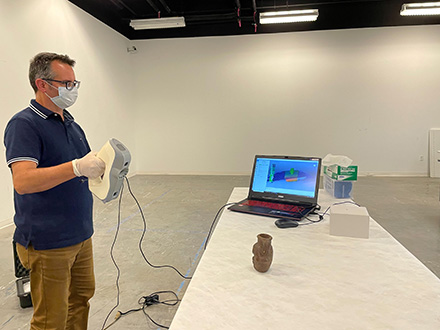A groundbreaking discovery by a University of South Florida (USF) professor has unveiled compelling evidence of ancient Egyptian rituals involving hallucinogenic cocktails. Analyzed by Dr. Davide Tanasi, a 2,000-year-old Egyptian mug has provided critical insights into the mystical practices of the ancient world.
A Rare Find and Its Intriguing Origins

The object of study is a rare Bes mug donated to the Tampa Museum of Art in 1984. These unique drinking vessels, adorned with the face of Bes—the ancient Egyptian god of fertility and childbirth—are highly uncommon, making this discovery all the more remarkable.
According to the Rosicrucian Egyptian Museum, Bes was often revered by newlyweds, a detail that aligns with the mug’s ritualistic significance. The mug has been part of the Tampa Museum of Art’s collection since 1984, but its secrets began unraveling only in 2021 when Tanasi and his team initiated their research.
Scientific Scrutiny Reveals Surprises
Initially, researchers believed the mug might have been used for alcoholic beverages. However, advanced DNA and chemical analysis shattered that assumption. Instead, they found a complex mixture—a “cocktail” containing an alcoholic base with an extraordinary array of additional components.
Among the ingredients were honey, royal jelly, sesame seeds, pine nuts, and licorice, alongside psychotropic substances such as Syrian rue, blue water lily, and cleome species.
Tanasi described the concoction as a “magical potion, meant to inebriate, satiate and induce hallucinations.”
The analysis also uncovered human fluids, including blood, breast milk, and mucus—strong indicators that the mixture played a role in ancient ritualistic practices.
A Glimpse into Ancient Incubation Rituals
“This first-of-its-kind finding provides physical evidence that mirrors written records and myths about ancient Egyptian rituals,” Tanasi explained.
The research suggests the psychotropic elements were used in “incubation rituals,” a practice where individuals would sleep in a sacred space, hoping to receive divine dreams for healing or guidance. “In [the] Greek cult of Asklepios, god of medicine, sick worshipers had to spend the night in the sanctuary and wait to be visited by the god curing them during their dreams. Those dreams were triggered by drugs (pharmaka) dispensed by the priests. So, our research confirms an earlier practice that has later comparisons in several other cultures.,” Tanasi elaborated.
These dreams, according to Tanasi, were often induced by drugs dispensed by priests—a practice mirrored in the use of the Bes mug’s hallucinogenic mixture.
Continuing the Journey of Discovery
Currently displayed as part of the “Prelude: An Introduction to the Permanent Collection” exhibit at the Tampa Museum of Art, the Bes mug stands as a testament to the ingenuity and mysticism of ancient Egyptian culture.
Looking ahead, Tanasi and his team aim to expand their research by analyzing similar Bes mugs housed at the Allan Pierson Museum in Amsterdam. These vessels, created from the same mold, could confirm whether this hallucinogenic concoction was a standardized element of rituals honoring Bes.
“To prove that the concoction that we found was the base recipe for a standard beverage administered during the rituals in honor of Bes, we plan as [a] next step to hopefully carry out the same analyses done on the example from the Tampa Museum of Art on other examples of [the] Bes Mug, kept at the Allan Pierson Museum in Amsterdam,” Tanasi shared.
The findings not only illuminate ancient Egyptian practices but also highlight the complex interplay between faith, medicine, and ritual in human history.



